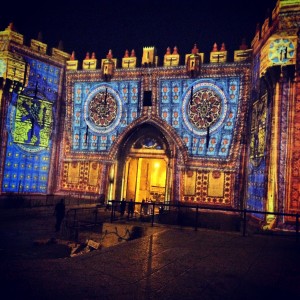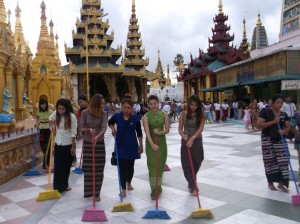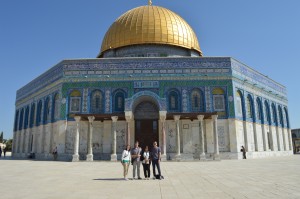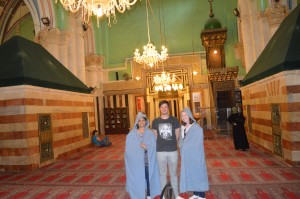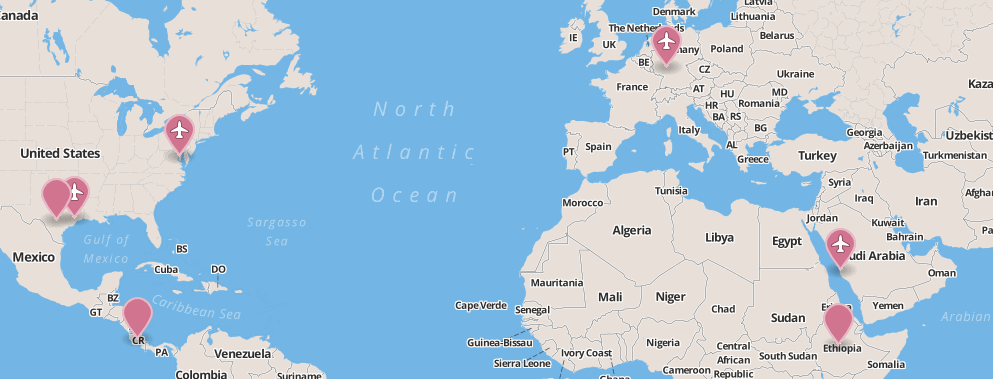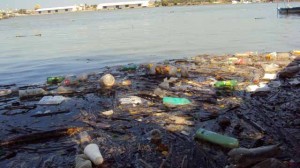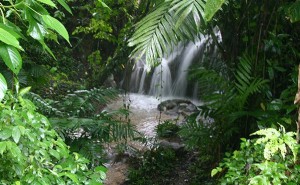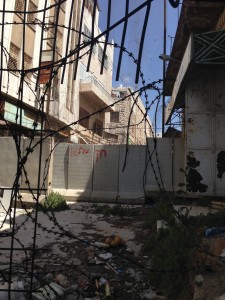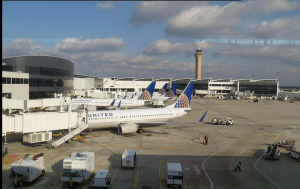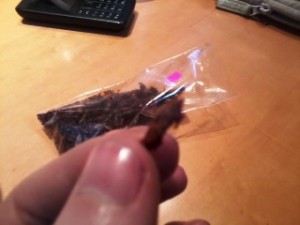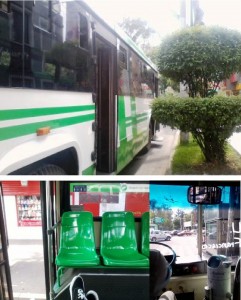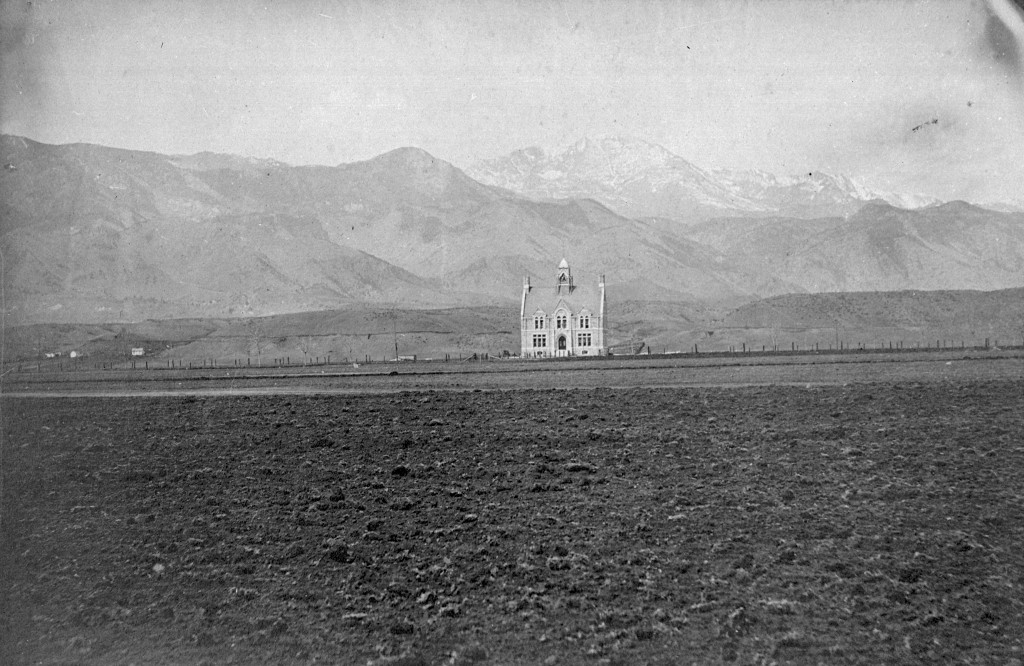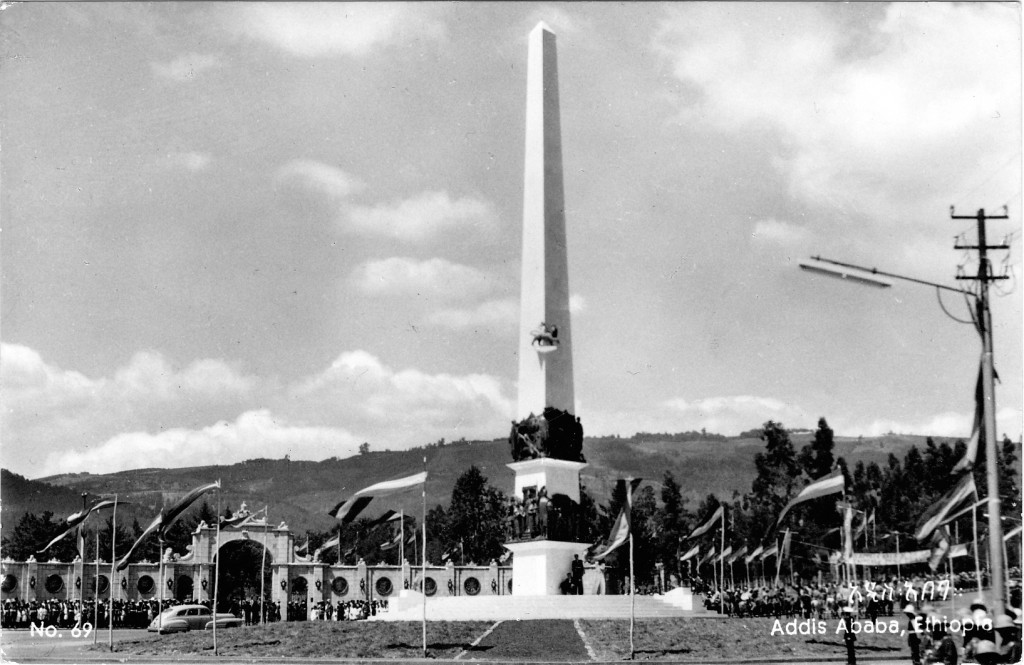Archive for June, 2014
Comfort in the Midst of Conflict
Posted by Allison Collender in Ally Collender, West Bank on June 15, 2014
Today marks two weeks since Lukas and I have arrived in Israel. It’s so weird typing that out… It feels like no time has passed at all. To think that 1/4 of this trip is already completed intimidates me. There is so much work we need to do research-wise, and there is so much more I want to experience. I swear, it feels like we arrived just a couple days ago.
It’s so strange how quickly I’ve become adjusted to this place. The other day while in Ramallah, we were trying to find a place to eat. It was overwhelming trying to find a place with hundreds of people walking around, and everything was in Arabic making it near impossible to find a place to sit down. My immediate response was, “Let’s go back to Jerusalem to eat.” Eventually we found a shawarma shop where one of the men working spoke English, and we were able to sit down and enjoy a good meal. But looking back, my reaction startles me. I haven’t been here that long, and when I’m in Jerusalem I still feel lost most of the time, yet I’ve become so comfortable here. Jerusalem has become my safety net.
This week has been the Festival of Lights in the Old City. All around the Jewish and Armenian quarters there are light projections on the walls and interesting art pieces around the streets. It’s so beautiful seeing the City lit up like this. The streets are filled with people, and there are even more carts than normal selling popcorn, cotton candy, and light-up toys. It’s been a lot of fun walking along the streets that we’ve become familiar with and seeing them in a new light (no pun intended… okay maybe that pun was slightly intentional).
While things seem fairly calm in Jerusalem, conflict is swarming around us. Earlier this week, 3 Israeli boys have gone missing in the West Bank while trying to hitch-hike outisde Hebron, and Israel believes that they have been kidnapped by Hamas. As I’m sure you gathered from Lukas’ post a few days ago, Hebron is already a very tense city – I cannot begin to imagine the energy moving through there now. In between football matches, Lukas will turn on the news to see if there are any updates about the missing boys. We are seeing this conflict evolve before our very eyes, and as a conflict analyst I am thrilled to be here experiencing it first-hand. But we are also very cautious – we’ve already decided that going back to Hebron would not be a smart decision at the moment. For now, we are staying informed, and hoping for the best for all parties.
Happenings
Posted by janine joyce in Burma, Janine Joyce on June 15, 2014
Happenings by their very nature defy definition. Yet if I was to try it would be a mixture of something random yet purposeful; unexpected yet perfect.
I really like being open to the type of random events that invariably lead to connection. Today we had such a happening.
We decided to go to an advertised antiques sale. Not really because there is any room in our bags or lives for antiques. And certainly not because it would be useful for the project. Rather because it caught my interest. For some reason the advertisement intrigued me.
We find ourselves knocking on the door at an inner city residential ward. I start laughing when I recognise the antipodean vowels of an Australian sister. As it happens she is an International humanitarian worker in the process of returning to her country. As such she is selling books and tapestries and beautiful artefacts accumulated whilst living many years abroad. It is interesting to see the inside of a Yangon apartment.
We begin to share stories when suddenly a voice says; ‘Are you Pushpa’s fellows?’
We look over to see a slender brunette woman holding some lovely scarves. Now you all know that Pushpa is the Director of this program, right?
We start laughing. It seems that it is todays happening to meet Susan who is the Yangon Director- Program Implementation for; Save the Children. She is so disappointed with the news that Pushpa is no longer visiting her for dinner tomorrow night. Greetings are shared and we will meet with her when we come back to Yangon after our journey north into the villages with Action Aid.
Happenings, I really like them. Of course, there have been other happenings also.
One evening a smiling Buddhist Abbott invited me to meet everyone at his monastery. It was wonderful to view the special stupa at the top of the five story monastery at sunset. I enjoyed sharing tea and spending time with the young novices.
Here is a small pic of the main Shwedagon Pagoda where we met. The women are sweeping the marble pavement clean.
The following day I joined the English language class where the Abbott was a student. There were several foreigners who had all been invited to practice English speaking with students. English was spoken with an American, French and Kiwi accent that morning.
In our group we were lucky that we could move from, ‘hello how are you’, ‘what’s your name’ and ‘are you single?’ The group absolutely loved it when we branched into Maori language from Aotearoa New Zealand. The Maori words; aroha/ love, karakia/ prayer; waiata/ song; kapai/ good and many others catapulted our conversation into all sorts of interesting areas. For two hours we shared ideas about women’s empowerment from Action Aids training material. We practiced various meditation techniques and the monk and I shared understandings about Buddhist dharma.
And whilst this photo doesn’t show it there was a lot of laughter….I promise!
West Bank and Israel – OMG!
Posted by Pushpa Iyer in Pushpa Iyer, West Bank on June 13, 2014
This was my first trip to Israel and the West Bank – well, in fact to the Middle East if I do not count my two-day trip in the late ’90s to Jordan! I had never imagined that I would enjoy the trip so much or that I would love the places I visited as much as I did, although I tore my hair with frustration with every sight and sound of the conflict that splits the people of this land.
Jerusalem and Bethlehem – so much history in one place! It was overwhelming to find myself standing in such historically significant places – what a privilege! Ally and Lukas were keen as one-week-old- hosts (although they have both been to the region before) to shown every place in these two cities that were important to anyone visiting.
We also went to Ramallah and Hebron. We planned to meet a colleague in an international NGO in Ramallah but Hebron happened simply by chance. We ran into a staff member of a Palestinian local organization and accepted his invitation to travel to Hebron.
Traveling to Palestinian controlled areas of Bethlehem, Ramallah and Hebron was such an experience. We saw with our own eyes every little indication of the conflict (and this included water conflicts), the incredible amount of violence that at this time definitely seemed one sided and against the Palestinians and we witnessed and experienced the indignities of passing through check points every time we returned to Jerusalem from the Palestinian controlled areas. And of course the separation wall was central to our separate experiences of Israel and Palestine.
So beautiful a region, such warm people… yet so harsh, so violent and so ghettoized. I kept wondering – why? Why is the human race so stupid? Why is the human race so cruel? Why is the human race so violent? Why is the human race so unforgiving? Why is the human race so determined to commit the same crimes of the past?
The last question hit me in the head, as a hammer would hit a nail when I toured the holocaust museum – Yad Vashem – Israel’s Memorial for the Jewish victims of the Holocaust. Why when the past shows how cruel, wrong, and despicable humans have been, are some of us so determined to continue the tradition today?
I have so many thoughts. So many feelings. I have emotions to sort through. I have so much more to write….but not I until I process my thoughts more.
Traveling to Addis Continued
Posted by Katie Petitt in Ethiopia, Katie Petitt on June 13, 2014
Day 3 & 4 6/10/14 & 6/11/14
I’m back! Houston Airport -> DC-> Frankfurt, Germany -> Saudi Arabia->Addis Ababa -> New Home
I love to travel, and if I could travel for the rest of my life I would be a happy woman. The last 5 days have been filled with travel and with that comes challenging myself, learning new phrases, new cultures, and learning more about myself and the world around me. To me travel is hopeful. Nothing ever goes to plan, but that is life, and you learn and grow and become a better you throughout it all. I have arrived to Addis and I couldn’t be more grateful.
Mexico, the environment and water issues
Posted by Ainhoa Martinez in Ainhoa Martinez, Mexico on June 12, 2014
The Mexican environment is a gift from the Mother Nature. The view that the environment provide is infinite, from the snow-capped volcanoes in the southern Valley of Mexico, to the full of cactus deserts commonly seen on Mexican movies, the wild jungles and the heavenly coast areas.
Respecting environmental issues, although Mexico is an oil producer and a developing country, it might be surprising that Local Government has manifest its aim to reduce the greenhouse gas emissions and had the objective to reduce them to half by 2050. Will they achieve that objective? These days the Energetic Reform is being discussed in a Commission at the Mexican Senate.
The geographical location of the country makes Mexico vulnerable to global warming and these last years, events such as hurricanes, droughts and floods may be attributed to the increase of the sea temperatures.
In addition, while its oil production decreases, Mexico discovers its potential for renewable energy. One-sixth part of its electricity comes from hydroelectric dams and also seeks foreign investment to develop solar energy.
Regarding water conflicts, the South territories of Mexico hold the 70% of the water, however, the North and the Central territories hold the 75% of the population. In total, about 11 million Mexicans (the 10% of the population) have no running water at home, and 15 million are living without sewage systems.
The aquifers in the North and Center are under increasing pressure from the cities, industry and agriculture. The North has suffered several droughts in the last two decades, which had affected agricultural production. And Mexico City turned to water shortages in 2009 due to a shortage record.
A lot of water is wasted. Because of leaks, about the half of the water supplies of the cities is lost. And about the half of the 75% of the country’s supply for agriculture is not used productively.
About the 80% of sewage water is not treated, which together with the waters of agrochemical runoff and large amounts of waste discharged into rivers and lakes, causes the contamination of the three quarters of the surface waters of Mexico (more or less).
Much of the sewage water from Mexico City is poured into the Panuco River, which empties into the Gulf of Mexico in Tampico. The Lerma River, which also caters to the capital, receives sewage water and industrial fluids in many other cities on their way to Lake Chapala, the largest natural lake in the country.
Jungles are also important as their conservation is key not only to fight against global warming, but also because they often are the source of water supplies.
The problems of the Federal District in terms of water supply, wastewater treatment, overcrowding and traffic pollution are reflected on a smaller scale in all rapidly growing cities.
Tourism development involves large-scale problems and threatens fragile ecosystems, especially in Baja California and the Caribbean coast. Due to uncontrolled urban development, new buildings threaten to deplete water resources, increase pollution and destroy wetlands.
Nevertheless, environmental awareness is growing stronger, but still there is no movement on a large scale, but you can find local organizations such as Pronatura, which allocates 100 million MXN to projects regarding climate change, priority species and land conservation.
The divided city of Hebron
Posted by Lukas Matzkows in Lukas Matzkows, West Bank on June 12, 2014
The last week was incredibly busy and so full of unforgettable impressions that I struggle with structuring all the thoughts in my head and write them down. One of the many places we visited, was the city of Hebron. It is one of Palestine’s biggest cities, located in the south of the West Bank. It is a city with a beautiful old city center, a once busy market and it is home to the tombs of Abraham, Sara and Isaac, which makes it a holy place for all of three religions in this country. It is also a city of division and conflict. Since 1979 religious jews have settled in and around the city and today the old town is home to around 30.000 Palestinians and 800 settlers. The city is divided in the areas H1, under Palestinian control, and H2, under full control of Israeli authorities.
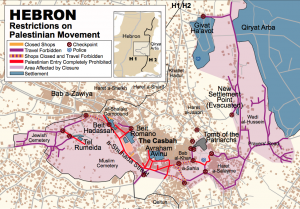
(https://www.btselem.org/download/200705_hebron_center_map_eng.pdf)
We entered the city with our guide Usama, from the Palestinian Conflict Transformation Center Wi’Am(which is Arabic for cordial relationships), who had a few heartbreaking stories to tell about his family and the ramifications of the ongoing conflict. He led us to the main street where at the first glimpse you would think it is a normal busy oriental city, but when you look up you notice something is different. The whole market area has an overhead fence which is bending down from the weight of litter. It has been set up by TIPH, an international observer mission that first came to Hebron following a massacre at the local mosque that left 29 male worshippers dead and 125 wounded. The fence protects the market from settlers who live on the second floor and through things at people and goods on display.
After that impression we visited the house of a friend of Usama. He lives almost wall on wall with settlers in Beit Hadassah. From his roof you can see Shuhada-Street, once a vibrant street where jewelers sold their goods. Today, the street is under full control of the settlers and Palestinians are not allowed to set foot in it anymore. Parts of it are completely shut down, in the rest, access is limited to Israelis. Shopkeepers that had their businesses here for generations had to abandon their shops and houses which led to an increase of unemployment and poverty. According to the UN, 75% of Palestinian residents of the old Souk area live under the poverty line. Usama’s friend told us stories and showed us videos of settlers climbing onto his roof to take down the Palestinian flag while soldiers stand by and watch. Standing on this roof, we could feel the tension that is all time present in this city and I was somewhat relieved once when we climbed down.
Our next stop, after crossing two more security checkpoints, was the beautiful Ibrahimi Mosque that has its own history. Following the events of 1994, the mosque was, as the city, divided. 40% remained a mosque, while 60% became a synagogue. Access to the mosque is completely controlled by the Israeli army, and completely restricted on jewish holidays. Inside we found stunning mosaics, paintings and the memorials of Abraham and Sara.
After that, we left the city the way we came, under the protection of the fence above.
Traveling to Addis
Posted by Katie Petitt in Ethiopia, Katie Petitt on June 10, 2014
In high school my favorite class was Astronomy. I loved learning about these far off things that affected us but also operated
completely separate from us. One day my teacher Mr. Atkins asked if we ever thought about the sun, if so what did we think of it. The smart-aleck cowboy in the class knew where our teacher was going with this and said “You know before now I only thought of the sun as that big bright thing that I curse every morning on the way to school cause my sun visor can’t block it out of my eyes. Now that I’m thinking about it, Mr. Atkins, I realize it is a big ball of burning gas that keeps us all alive”.
Agur Basque Country, Hola Mexico!
Posted by Ainhoa Martinez in Ainhoa Martinez, Mexico on June 10, 2014
5.30 pm of Thursday the 5th, I have just finished the last exam of my LLB. I cannot believe Law School is now over and in less than 2 days I will be on my way to Mexico City. A good plan for my last hours in Vitoria-Gasteiz? To have dinner with my best friends in one of our favorites Italian restaurants and have some drinks.
The day before starting my trip I had lunch with my family, packed up everything I need for the trip and said goodbye to my beloved family and friends.
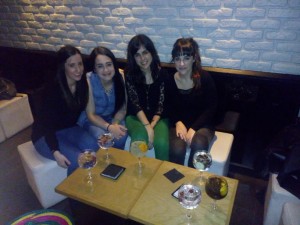
See you soon girls!
Having some drinks after dinner with my best friends in Vitoria-Gasteiz, to celebrate we have finished our LLB and my trip to Mexico.
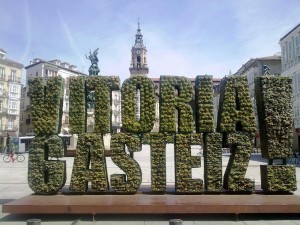
Hometown.
Vitoria-Gasteiz is where I live. It is the capital city of the Basque Country and in 2012 it was awarded as the European Green Capital. This monument made of shrubbery was designed to represent the award and it stands in the center of the city.
I have been lucky because 4 days before my departure I got in contact with a woman who was renting a room for students in the area of Coyoacan, where Jessica is living. I saw the house and the room via Skype and we reached an agreement. So having solved all this issue about accommodation, before my arrival to Mexico City, have been truly handy. I will not have to go mad booking a hotel room and wondering around the city looking for a place to live.
4 am of Friday the 7th, the airport is just one hour away from my home and is easy to get there. First I will travel from Bilbao to Paris and then get the flight to Mexico City. There were so many security controls between Bilbao and Paris and the Parisian airport was so big that I almost got lost, but I finally reached the gate for my flight and as I had 3 hours left until the departure I had lunch in one of the restaurants. Got my tickets and passport ready to take my sit in the flight, if you had ever travelled such long distance you will guess I am sitting next to the corridor because your body and mind can get really tired during the 10 hours of journey and it is good to walk every hour to avoid having pain in your knees, ears or headache.
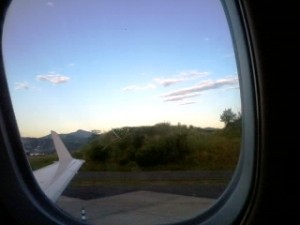
The plain is about to take off.
The journey starts in the airport of Bilbao. Incredible view from the window, the sky is quiet and calm.
Finally I landed in Benito Juarez International airport at 6.30 pm local time. There are 7 hours of time difference between Mexico and Spain and I hope the jetlag does not catch me. I went through the migration controls and got my luggage. One more thing to do before I walk over Mexican floor: I had to press a button and if the light goes green I walk forward, but if the light goes red I have to open my luggage to be inspected. Please go green, please go green… It’s green light! Thank God! I was so tired I did not want to start taking everything out of the luggage.
From 6 pm onwards it’s rush hour in the Mexican airport because it is the arrival time for most flights coming from Europe. The place was crowded, but I finally found Jessica and we took a safe taxi to get home. During the journey, the long roads and the old buildings I she through the window of the cab reminds me of the summer I spent in Beijing. Everything looks more or less the same, like a massive city, full of traffic, where wealth and poverty are separated by only a few steps.
First must-to-do things in Mexico City:
1. Settle in the house.
2. Walk around the area and locate important places such as public transport areas, restaurants and supermarkets.
3. Do the shopping! (you must be starving).
4. Find secure taxi numbers, maps and other practical information.
5. Get a Mexican cell phone. It can be easily bought in OXXO or Moviestar shops for 300 MXN.
And do not forget to try “Chapulines”, if you don’t try them you won’t live the Mexican experience. Jessica took me to a little place in Miguel de Quevedo Avenue and bought some. I just tried two and it was a mixture of spicy and salt with a lot of proteins. For a non Mexican person it was very spicy, as Mexicans say “Me enchilé”.
Regarding the Coyoacan area, I really like the house where I am living, there are 3 more students living here and every Monday and Friday a housekeeper cooks for us traditional Mexican food (I hope I can share with you a blog entry on this issue in the future). The first morning I woke up and found a welcome message written on the board of the kitchen. Rita, the owner of the house, prepared me a huge and delicious breakfast to recover from the long journey and the other students living in the house and I started talking. It seems like we have a lot in common, two of them are studying music and I play the acoustic guitar and the ukulele. The neighborhood is calm and both public transport and supermarkets are close to the house.
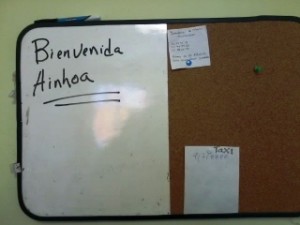
Welcome message.
Rita (the owner) and other students living in the house left me a welcome message written on the board of the kitchen, followed by a delicious and energetic breakfast the morning after my arrival.
Jessica and I decided to stablish our meeting place in a Starbucks, which is halfway between her home and mine, we have like a 10 minute travel by “Trole-bus” to get there. It is funny the first time I took the Trole-bus alone, it suddenly broke down and had to wait a lot until another one picked me from the middle of nowhere, but it was okay and I easily found Jessica.
We spent my 3rd day in Mexico City walking through the main streets of Coyoacan and it is such an active and full of live place where you can find different street markets, parks, all the food shops that you can imagine…
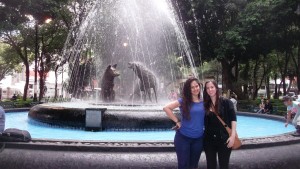
The center of Coyoacan.
This is Jessica and me, standing in front of a fountain in a park. The 2 coyotes in the middle of the fountain give the name to this beautiful area, Coyoacan.
My way back home early at night was such a challenge for me because more or less I could locate myself in the area during the day, but the sun had already gone. There was no problem, I took another Trole-bus to “Taxqueña” main street and just had to walk a couple of streets to reach home. So the first day walking around the place alone went pretty well.
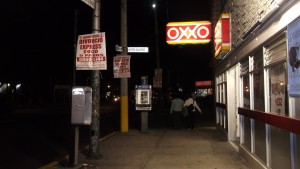
On my way back home at the end of the day.
Here you can find one of the OXXO shops, which are so popular around the city.
Life in Mexico seems to be very “relaxing” so we had better not to be in a hurry if we need to do something. That could summarize the Mexican way of living.
P.S.: “Agur” means goodbye in Basque language and I suppose everyone will know that “Hola” means hello.
History in the Streets
Posted by Phoenix McLaughlin in Ethiopia, Phoenix McLaughlin on June 10, 2014
This is what my college looked like when it was founded 140 years ago. I remember seeing this picture for the first time in that very building, Cutler Hall, and feeling a pang of historical awe. Now there are many buildings, not to mention grass and trees, that surround Cutler at Colorado College, and it is in the middle of the 600,000-person city of Colorado Springs. I can always remember the sensation of historical connection while looking at that picture. It gave me a glimpse of the story of the ground on which I stood. The places I have lived—Norway, Maine; Hampton, New Hampshire; and Colorado Springs, Colorado—tend to not be featured too strongly in the history books, so such insights into the places’ histories are rare.
Now I am walking the storied streets of Addis Ababa, Ethiopia, and I have been presented an opportunity for connecting to history on a level I had never imagined. The history of the city and the country is dramatic, and I found a source for discovering it in the book Cutting for Stone. It is a fantastic read. It is a semi-fictionalized autobiographical account of Addis in the mid-20th century, and it illuminates the period extremely well. The historical facts alone are interesting, but the book has brought them to life. It has made my walking around town feel much more significant.
Throughout the book and throughout Ethiopia, Haile Selassie is a monumental figure (although not always a positive one). He ruled Ethiopia for forty years and gave the country an air of stability and prestige that stood out to the world. It was because of this that Addis became a sort of capital for Africa—the African Union is based here, with the massive new headquarters visible from my hostel. Haile Selassie went beyond a mere political leader for some. A centerpiece of Rastafarian belief is that he was in fact the second coming of Jesus Christ—“an idea he didn’t mind his own people believing, but when it came from so far away and for reasons that he didn’t understand, made him wary.” He was traditionally believed to be a descendant of King Solomon and bore the appropriately modest title: His Imperial Majesty the King of Kings of Ethiopia, Conquering Lion of the Tribe of Judah, Elect of God. I am not used to walking on the same ground as people with those kinds of names. There are not many King of Kings in the U.S.
In the book, the main character sees the legendary Emperor Haile Selassie’s motorcade roll by one day—“The ground shook as the Ducatis slid past…His majesty’s green Rolls-Royce was polished to a mirrorlike finish. On a built-up seat, His Majesty looked out of windows specially constructed for monarchs to view and be viewed.” Yesterday, not long after reading this passage, I was treated to a motorcade experience of my own. The roads were closed off for miles all around; it took me 15 minutes of walking through streets emptied of cars before I finally came across the motorcade. A soldier halted me on the sidewalk to let some 25 cars, vans, and motorcycles scream by, each containing various men in suits. It would have been an interesting occasion regardless, but half expecting an emperor to roll by made it feel all the more important.
Alas, there was no emperor, since that title no longer exists in Ethiopia. Not much later in the book, a coup occurs, a fictionalized version of a real coup attempt in 1960. The book describes the clashing forces, the competition and eventual violence between the rebelling Imperial Bodyguard and the loyal Army, Air Force, and Police. Selassie was eventually deposed by another coup in 1974. With those images in mind, walking by the men in uniform sprinkled around the various armed forces headquarters in Addis gains new significance. The book has done the job of connecting them to their past, a tale of turmoil and conflict lasting into the 1990s.
One reason this history is so fascinating is that it is so recent. While my parents were pre-teens taking dance classes or playing ball in the yard, the man some considered to be the son of God was being overthrown by communists in the city in which I now live. Reading such a descriptive story set in Addis Ababa’s not-so-distant past has helped solidify a connection to that drama. I am only about halfway through Cutting for Stone, so I expect I will find some more history to revel in as I walk around Addis Ababa. It has already amplified my experience here to a great degree. Whether it be a college or a city, there is simply something extraordinary about tapping into the past of a place. I hope to do it more often.
Adventures in Jerusalem
Posted by Allison Collender in Ally Collender, West Bank on June 6, 2014
Over the past few days, Lukas and I have had the opportunity to do even more sight-seeing!
Yesterday we spent time at the Garden Tomb, which is where some Christians believe that Jesus was buried after his crucifixion. The other well-known location of where the burial might have taken places is located at the Church of the Holy Sepulchre, which we have been waiting for Pushpa to arrive for us to visit. The Garden Tomb was incredibly peaceful. Like the name suggests, is a very large garden on the outskirts of the Old City. They also offer free tours, which was great because most of the sightseeing Lukas and I have done has been on our own. It was nice for someone to tell us stories, rather than rely on our memories of our previous visit.
This morning, we decided to go on the Rampart Walk, which is a catwalk that goes around the perimeter of the Old City. There are technically two different sections of the Walk, but unfortunately one end was closed off, but we still enjoyed ourselves. We ended up making friends with 3 couples who were on a tour group together, and had some free time before the left to explore the Old City. After we finished the Walk, we showed them some other areas of the Old City they hadn’t seen before, like the overlook of the Western Wall. It’s really surprising how quickly Lukas and I have learned our way around the place. Okay, maybe I haven’t really gotten the directions sorted out, but I can always rely on Lukas to figure out the right way to go! Below is a picture of us on the Rampart Walk.
This evening, Pushpa arrived to visit us! After grabbing some falafel for dinner, we decided to give her a mini-tour of the Old City. Like we did with our friends before, we took her to see the overlook of the Western Wall. Shabbat, the Jewish holy day, began tonight at sundown, so there were so many people at the Western Wall praying. And while we were watching, the Muslim call to prayer began to play as well. I cannot begin to describe how amazing it was to experience both of these religious ceremonies occur at the same time. Israel has such a wide array of culture, but it’s often divided amongst religious sects. It was beautiful to see these two religious groups overlap one another.
Tomorrow we will be going to visit Bethlehem, where we will see the Church of the Nativity and walk along the Separation Wall and see all the graffiti. The graffiti is absolutely incredible, and I am sure we will have some good pictures and stories to share from that trip.
